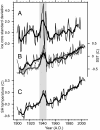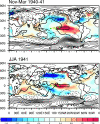Ice cores record significant 1940s Antarctic warmth related to tropical climate variability
- PMID: 18697932
- PMCID: PMC2527881
- DOI: 10.1073/pnas.0803627105
Ice cores record significant 1940s Antarctic warmth related to tropical climate variability
Abstract
Although the 20th Century warming of global climate is well known, climate change in the high-latitude Southern Hemisphere (SH), especially in the first half of the century, remains poorly documented. We present a composite of water stable isotope data from high-resolution ice cores from the West Antarctic Ice Sheet. This record, representative of West Antarctic surface temperature, shows extreme positive anomalies in the 1936-45 decade that are significant in the context of the background 20th Century warming trend. We interpret these anomalies--previously undocumented in the high-latitude SH--as indicative of strong teleconnections in part driven by the major 1939-42 El Niño. These anomalies are coherent with tropical sea-surface temperature, mean SH air temperature, and North Pacific sea-level pressure, underscoring the sensitivity of West Antarctica's climate, and potentially its ice sheet, to large-scale changes in the global climate.
Conflict of interest statement
The authors declare no conflict of interest.
Figures



References
-
- Rignot E, et al. Recent Antarctic ice mass loss from radar interferometry and regional climate modeling. Nat Geosci. 2008;1:110.
-
- Johanson CM, Fu Q. Antarctic atmospheric temperature trend patterns from satellite observations. Geophys Res Lett. 2007;34:L12703.
-
- Comiso JC. Variability and trends in Antarctic surface temperatures from in situ and satellite infrared measurements. J Clim. 2000;13:1674–1696.
-
- Schneider DP, Steig EJ, Comiso JC. Recent climate variability in Antarctica from satellite-derived temperature data. J Clim. 2004;17:1569–1583.
-
- Monaghan AJ, Bromwich DH, Chapman W, Comiso JC. Recent variability and trends of Antarctic near-surface temperature. J Geophys Res Atmos. 2008a;113:D04105.
Publication types
MeSH terms
LinkOut - more resources
Full Text Sources

